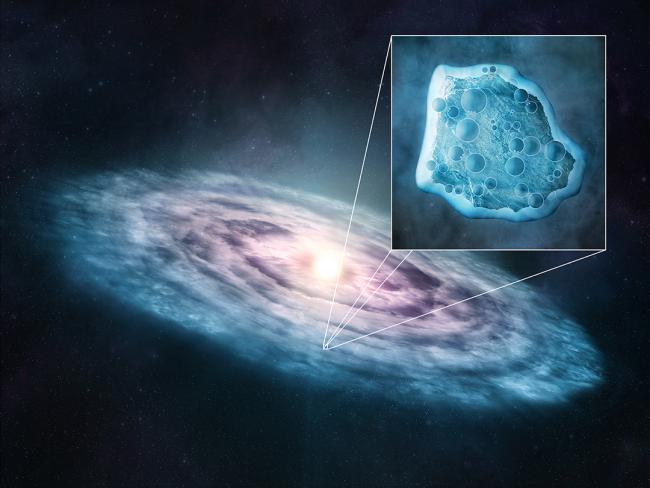Carbon Monoxide is Plentiful in Nebulae, but Then Disappears When Planets Form. Now we Know Where it Goes!
By Carolyn Collins Petersen
Protoplanetary disks—those nurseries around young stars where planets form—are filled with gas and dust. In particular, many show a lot of carbon monoxide gas. It’s a handy “tracer” to estimate the mass of a cloud, its composition, and even its temperature. It’s also easy to observe. However, astronomers think there should be more of it than they’re observing in many disks. And that prompted a question: where’s the rest of it?
This has been a problem for astronomers over the last decade or so. Something hasn’t been adding up when it comes to carbon monoxide observations in protoplanetary disks, according to Diana Powell, a NASA Hubble Fellow at the Center for Astrophysics-Harvard & Smithsonian. A huge chunk seems to be missing. “This may be one of the biggest unsolved problems in planet-forming disks,” she said. “Depending on the system observed, carbon monoxide is three to 100 times less than it should be; it’s off by a really huge amount.”
Solving a Carbon Monoxide Mystery
Is this an inaccuracy in measurement, or is there something else going on? It’s important to astronomers and to the field of astrochemistry, enough so that Powell decided to figure it out. If it’s an inaccurate measurement issue, that could change astronomers’ understanding of the disks, she points out. “This could mean many of our results for disks have been biased and uncertain because we don’t understand the compound well enough,” she said.
One possible answer to the mystery of the missing carbon monoxide is “phase changes.” That’s when matter morphs from one state to another, like a gas changing into a solid, or a liquid becoming a vapor. Could the carbon monoxide in some clouds be changing phases? And how and when would that happen in a protoplanetary nebula?
To answer those questions, Powell made alterations to an astrophysical model that scientists use to study clouds on exoplanets. It takes into account the detailed physics of how ice forms on particles, explained Powell. “So how ice nucleates onto small particles and then how it condenses. The model carefully tracks where ice is, on what particle it’s located on, how big the particles are, how small they are, and then how they move around.”
Creating a New Model
The next step was to take the adapted model and apply it to simulate conditions in planetary disks. Powell’s idea was to see how carbon monoxide changes over time in the gas- and dust-rich planet-forming clouds. She then compared the adapted model’s results with actual observations of the disks TW Hya, HD 163296, DM Tau, and IM Lup made by the Atacama Large Millimeter Array in Chile. The results and model agreed. Powell was able to show that the four disks weren’t actually missing carbon monoxide at all. In fact, it’s all still there. It just morphed from a gaseous state (detectable with observatories such as ALMA) into ice, not detectable with a telescope. In fact, the new model shows that carbon monoxide forms on large particles of ice in a protoplanetary nebula.

So, now astronomers have a new way of thinking about CO in planet-forming clouds. In addition to all the other characteristics that carbon monoxide traces, it gives a handy way to estimate a cloud’s age. The nucleation of carbon monoxide onto ice particles that are already in the cloud starts to happen about a million years into the planet-forming phase. If a disk shows a lot of carbon monoxide, it’s pretty young—less than a million years. That’s because all its carbon monoxide is in the gaseous state. If a disk doesn’t show a lot of carbon monoxide, then it’s likely older than a million years. Its carbon monoxide froze out into chunks of ice.
“This changes how we thought ice and gas were distributed in disks,” Powell says. “It also shows that detailed modeling like this is important to understand the fundamentals of these environments.”
Next Steps
Now that JWST is online, could it be used to observe specific planetary nurseries? If so, that might help validate Powell’s model further. It turns out that JWST might possibly have the spectral capability to observe ice in these disks. If it does, using it to further apply the physics of phase changes to understanding protoplanetary disks will be (pun intended) really cool.
For More Information
For More Information
Case Solved: Missing Carbon Monoxide was Hiding in the Ice
Depletion of gaseous CO in protoplanetary disks by surface-energy-regulated ice formation
The post Carbon Monoxide is Plentiful in Nebulae, but Then Disappears When Planets Form. Now we Know Where it Goes! appeared first on Universe Today.

August 26, 2022 at 02:26AM
via Universe Today read more...

Post a Comment